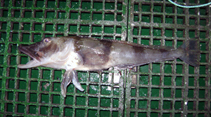Chaenocephalus aceratus (Lönnberg, 1906)
Blackfin icefish
Waarneming toevoegen in Fish Watcher
| Native range | All suitable habitat | Point map | Year 2050 |

|
| This map was computer-generated and has not yet been reviewed. |
| Chaenocephalus aceratus AquaMaps Data sources: GBIF OBIS |
Uploaden van uw Foto's en video's
Pictures | Stamps, coins, misc. | Google afbeeldingChaenocephalus aceratus
Picture by Reyes, P.
Pictures | Stamps, coins, misc. | Google afbeeldingChaenocephalus aceratus
Picture by Reyes, P.
Common names from other countries
Classificatie / Names Lokale namen | Synoniemen | Catalog of Fishes(Genus, Soort(en)) | ITIS | CoL | WoRMS | Cloffa
> Perciformes/Notothenioidei (Icefishes) > Channichthyidae (Crocodile icefishes)
Etymology: Chaenocephalus: Greek, chaeno = to yawn + Greek, kephale = head (Ref. 45335).
More on author: Lönnberg.
Etymology: Chaenocephalus: Greek, chaeno = to yawn + Greek, kephale = head (Ref. 45335).
More on author: Lönnberg.
Environment: milieu / climate zone / depth range / distribution range Ecologie
marien demersaal; diepte 5 - 770 m. Polar; 53°S - 65°S, 67°W - 4°E
Verspreiding Landen | FAO regio's | Ecosystemen | Voorkomen | Point map | Introducties | Faunafri
Southern Ocean: in the vicinity of Bouvet Island, Scotia Sea, and northern part of the Antarctic Peninsula.
Lengte bij maturiteit / Grootte / Gewicht / Leeftijd
Maturity: Lm 44.9 range ? - ? cm
Max length : 72.0 cm TL mannelijk / geslacht onbekend; (Ref. 4883); common length : 50.0 cm TL mannelijk / geslacht onbekend; (Ref. 2805); max. gepubliceerd gewicht: 3.7 kg (Ref. 4883)
Max length : 72.0 cm TL mannelijk / geslacht onbekend; (Ref. 4883); common length : 50.0 cm TL mannelijk / geslacht onbekend; (Ref. 2805); max. gepubliceerd gewicht: 3.7 kg (Ref. 4883)
Adults feed mostly on fish and krill. Synchronous spawner (Ref. 50743). Larvae have a long pelagic phase (Ref. 71843). Utilized as a food fish (Ref. 4931).
Levenscyclus en paargedrag Maturiteit | Voortplanting | Paaien | Eieren | Fecunditeit | Larven
There is only one generation of oocytes in the ovaries indicative of determinate fecundity (Ref. 50743). Mature females may spawn for the first time from around 6-8 years of age (Ref. 71843).
Hoofdreferentie
Upload your references | Referenties | Coördinator | Medewerkers
Hureau, J.-C., 1985. Channichthyidae. p. 261-277. In W. Fischer and J.C. Hureau (eds.) FAO species identification sheets for fishery purposes. Southern Ocean (Fishing areas 48, 58 and 88). Rome. Vol. 2. (Ref. 2805)
Status op de Rode Lijst van het IUCN (Ref. 130435: Version 2024-2)
Kwetsbaar, zie IUCN Rode Lijst (VU) (A2bcde); Date assessed: 29 November 2023
Gevaar voor de mens
Harmless
Gebruik door de mens
Visserij: van minder commercieel belang
FAO(visserij: productie; publication : search) | FishSource | Sea Around Us
Meer informatie
Population dynamics
Groeiparameters
Max. ages / sizes
Length-weight rel.
Length-length rel.
Lengtefrequenties
Massaconversie
Rekrutering
Abundantie
Groeiparameters
Max. ages / sizes
Length-weight rel.
Length-length rel.
Lengtefrequenties
Massaconversie
Rekrutering
Abundantie
Life cycle
Voortplanting
Maturiteit
Fecunditeit
Paaien
Spawning aggregations
Eieren
Ontwikkeling van de eieren
Larven
Larvale populatiedynamiek
Voortplanting
Maturiteit
Fecunditeit
Paaien
Spawning aggregations
Eieren
Ontwikkeling van de eieren
Larven
Larvale populatiedynamiek
Physiology
Body composition
Nutrients
Zuurstofverbruik
Zwemtype
Zwemsnelheid
Visual pigments
Fish sound
Diseases & Parasites
Toxicity (LC50s)
Body composition
Nutrients
Zuurstofverbruik
Zwemtype
Zwemsnelheid
Visual pigments
Fish sound
Diseases & Parasites
Toxicity (LC50s)
Human related
Aquaculture systems
Aquacultuurprofielen
Kweeklijnen
Ciguatera cases
Stamps, coins, misc.
Aquaculture systems
Aquacultuurprofielen
Kweeklijnen
Ciguatera cases
Stamps, coins, misc.
Tools
E-boek | Veldgids | Determinatiesleutels | Lengtefrequentie Tool | Levenscyclus tool | Verspreidingskaart | Classification Tree
| Catch-MSY |
Speciale rapporten
Bekijk gegevens voor het houden in een aquarium | Bekijk Fact Sheets voor de soort | Bekijk Aquacultuur Fact Sheets
Download XML
Internetbronnen
Aquatic Commons | BHL | Cloffa | Websites from users | Bekijk FishWatcher | CISTI | Catalog of Fishes(Genus, Soort(en)) | DiscoverLife | ECOTOX | Faunafri | Fishtrace | GenBank(genoom, nucleotide) | GloBI | GOBASE | | Google Books | Google Scholar | Google | IGFA World Record | MitoFish | Otolith Atlas of Taiwan Fishes | PubMed | Reef Life Survey | Scirus | SeaLifeBase | Tree of Life | Wikipedia(ga naar, zoek) | World Records Freshwater Fishing | Zoological Record
Estimates based on models
Preferred temperature (Ref. 115969): -1.3 - 1.6, mean 0 (based on 42 cells).
Fylogenetische diversiteitsindex (Ref. 82804): PD50 = 1.0000 [Uniqueness, from 0.5 = low to 2.0 = high].
Bayesian length-weight: a=0.00093 (0.00079 - 0.00110), b=3.48 (3.43 - 3.53), in cm Total Length, based on LWR estimates for this species (Ref. 93245).
Trofisch niveau (Ref. 69278): 3.4 ±0.2 se; based on diet studies.
Weerstandsvermogen (Ref. 120179): Gemiddeld, minimale populatieverdubbelingstijd 1,4-4,4 jaar (K=0.17-0.24; Fec = 7,358).
Fishing Vulnerability (Ref. 59153): Moderate to high vulnerability (54 of 100).
Climate Vulnerability (Ref. 125649): High to very high vulnerability (75 of 100).




